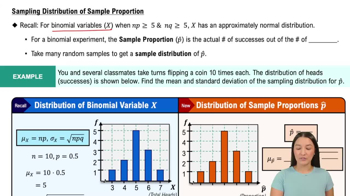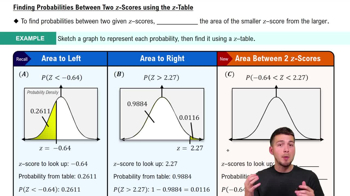You want to arrange the books on your bookshelf by color. How many different ways could you arrange 12 books if 4 of them have a blue cover, 3 are yellow, and 5 are white?
Table of contents
- 1. Intro to Stats and Collecting Data1h 14m
- 2. Describing Data with Tables and Graphs1h 55m
- 3. Describing Data Numerically2h 5m
- 4. Probability2h 16m
- 5. Binomial Distribution & Discrete Random Variables3h 6m
- 6. Normal Distribution and Continuous Random Variables2h 11m
- 7. Sampling Distributions & Confidence Intervals: Mean3h 23m
- Sampling Distribution of the Sample Mean and Central Limit Theorem19m
- Distribution of Sample Mean - Excel23m
- Introduction to Confidence Intervals15m
- Confidence Intervals for Population Mean1h 18m
- Determining the Minimum Sample Size Required12m
- Finding Probabilities and T Critical Values - Excel28m
- Confidence Intervals for Population Means - Excel25m
- 8. Sampling Distributions & Confidence Intervals: Proportion1h 12m
- 9. Hypothesis Testing for One Sample3h 29m
- 10. Hypothesis Testing for Two Samples4h 50m
- Two Proportions1h 13m
- Two Proportions Hypothesis Test - Excel28m
- Two Means - Unknown, Unequal Variance1h 3m
- Two Means - Unknown Variances Hypothesis Test - Excel12m
- Two Means - Unknown, Equal Variance15m
- Two Means - Unknown, Equal Variances Hypothesis Test - Excel9m
- Two Means - Known Variance12m
- Two Means - Sigma Known Hypothesis Test - Excel21m
- Two Means - Matched Pairs (Dependent Samples)42m
- Matched Pairs Hypothesis Test - Excel12m
- 11. Correlation1h 6m
- 12. Regression1h 50m
- 13. Chi-Square Tests & Goodness of Fit1h 57m
- 14. ANOVA1h 57m
4. Probability
Counting
Problem 4.4.4
Textbook Question
Combination Lock The typical combination lock uses three numbers, each between 0 and 49. Opening the lock requires entry of the three numbers in the correct order. Is the name “combination” lock appropriate? Why or why not?
 Verified step by step guidance
Verified step by step guidance1
Step 1: Understand the difference between a combination and a permutation. A combination refers to selecting items where the order does not matter, while a permutation refers to selecting items where the order does matter.
Step 2: Analyze the problem. The lock requires the three numbers to be entered in a specific order to open it. This means the order of the numbers is crucial.
Step 3: Determine whether the term 'combination' is appropriate. Since the order of the numbers matters in this scenario, the term 'combination' is not technically correct. The correct term would be 'permutation.'
Step 4: Calculate the total number of possible permutations for the lock. Since there are three numbers to be entered, each between 0 and 49, the total number of permutations can be calculated using the formula for permutations: \( n^r \), where \( n \) is the number of choices for each position and \( r \) is the number of positions. Here, \( n = 50 \) and \( r = 3 \).
Step 5: Conclude that the name 'combination lock' is a misnomer because the lock operates based on permutations, not combinations, as the order of the numbers is essential.
 Verified video answer for a similar problem:
Verified video answer for a similar problem:This video solution was recommended by our tutors as helpful for the problem above
Video duration:
3mPlay a video:
Was this helpful?
Key Concepts
Here are the essential concepts you must grasp in order to answer the question correctly.
Permutations vs. Combinations
In statistics, permutations refer to the arrangement of items in a specific order, while combinations refer to the selection of items without regard to order. The term 'combination lock' is misleading because the order of the numbers matters for unlocking, which aligns with permutations rather than combinations.
Recommended video:

Permutations vs. Combinations
Sample Space
The sample space in probability is the set of all possible outcomes of a random experiment. For the combination lock, the sample space consists of all possible sequences of three numbers chosen from the range of 0 to 49, which amounts to 50 options for each number, leading to a total of 50^3 (125,000) possible combinations.
Recommended video:

Sampling Distribution of Sample Proportion
Order of Operations
The order of operations is crucial in determining the correct sequence in which to enter the numbers on a combination lock. Since the lock requires the numbers to be entered in a specific order, understanding this concept is essential to grasp why the term 'combination' is not appropriate, as it implies a disregard for the sequence.
Recommended video:
Guided course

Probabilities Between Two Values

 7:11m
7:11mWatch next
Master Introduction to Permutations with a bite sized video explanation from Patrick
Start learningRelated Videos
Related Practice
Multiple Choice
